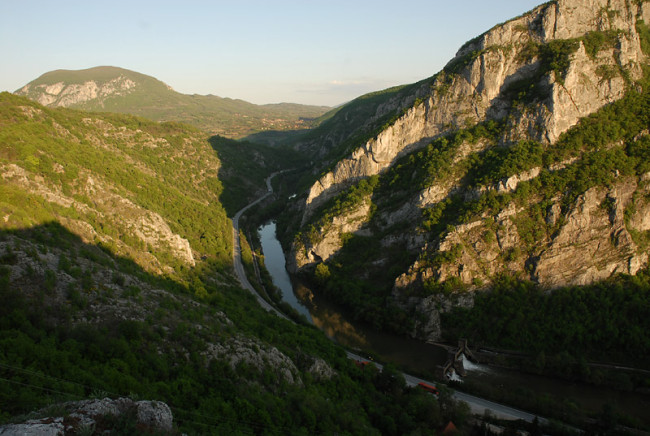The Sićevačka Klisura gorge is in eastern Serbia and is located on the territories of the city of Niš and the town of Bela Palanka. The most striking aspect of the landscape in the Sićevo
This region is the Nišava river valley which, because of its unusual geology and the village of Sićevo at its heart, is called the Sićevačka Klisura (the Sićevo Gorge). It extends from the village of Dolac, which marks the exit from the Bela Palanka basin, to the village of Prosek at the entrance to the Niš basin, a length of some 17 km.
It was formed by the Nišava river carving a path into the limestone. This large composite gorge is comprised of three distinct morphological parts. Gradištanski Kanjon, 7 km long and carved out between the hill of Oblik and the Svrljig mountains, is the most beautiful part of the gorge. The tight, almost vertical, step-cut stone cliffs are the nesting-grounds of the last pairs of Golden Eagles in Serbia. Towards its base, the width of the canyon is for the most part reduced to the width of the Nišava river bed, the stony canyon wall reaching as high as 400 m. At the exit from the canyon is the hill of Oblik where, together with the Jelašnica Gorge, we find the shared habitat of two tertiary age relicts – endemic Balkan species – the Serbian phoenix flower (Ramonda serbica) and Natalie’s ramonda (Ramonda nathaliae).
Downriver, between the Saint Petka monastery and the mouth of the Ostrovica stream, the Nišava flows for some 2 km through a basinlike widening with a wide bed and open, slightly angled sides. The section of the valley downriver from the monastery is known as the Prosek Gorge. This extends for some 8 km and is geologically very diverse.
To the left of the gorge stretches the Ostrovička Udolina basin, into which is carved a valley and where most of the Ostrovički Potok stream flows.
The surrounding limestone rock is notable for the karst forms which appear there. On the surface we can see karst features such as kamenica, karren and sinkholes, while fascinating underground features include numerous caves, rock-shelters, potholes, spurs and others.
One of the general characteristics of the Sićevačka Klisura landscape are its steplike natural formations, visible in the vertical alternation of level surfaces and its abrupt declivities of varying steepness.
Mediaeval Orthodox monasteries can be found in the Sićevačka Klisura, as well as the remains of the famous Roman road, the Via Militaris.
INFORMATION
JP “Srbijašume”
Šumsko gazdinstvo “Niš”
Prvomajska 4b, 18000 Niš
tel: +381 (0)18 520-043, fax: 46-074
www.srbijasume.rs

